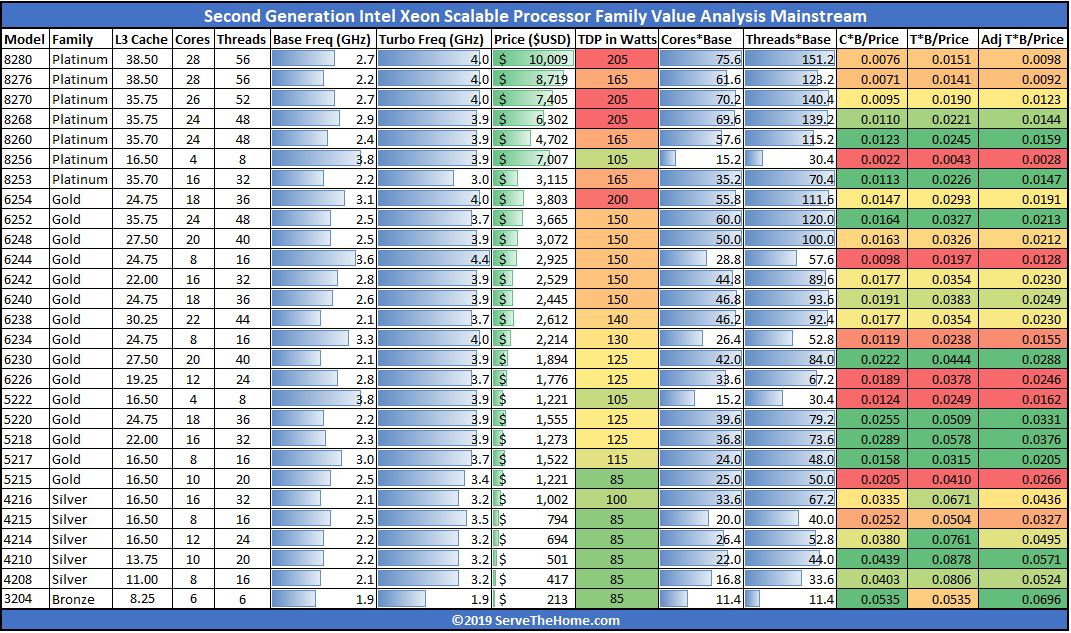Intel Xeon Gold 6240 Market Positioning
Thes chips are not released in a vacuum instead, they have competition on both the Intel and AMD sides. When you purchase a server and select a CPU, it is important to see the value of a platform versus its competitors.
Intel Xeon Gold 6240 v. Intel Alternatives
If you need higher clock speeds and fewer cores than the Intel Xeon Gold 6230 has to offer, we think the Intel Xeon Gold 6240 makes a lot of sense. It offers a better cost per core * clock ratio than the Intel Xeon Gold 6242 or Gold 6238.
Here is a view from our Second Generation Intel Xeon Scalable SKU List and Value Analysis piece on the mainstream CPUs:

For the time being, this is a SKU that makes a lot of sense as a good balance of per-core performance and multi-thread capacity.
There are three public variants of the Xeon Gold 6240 SKU:
- Xeon Gold 6240M – Medium memory support with up to 2TB memory capacity (up from 1TB on the part we tested.)
- Xeon Gold 6240L – Large memory support with up to 4.5TB memory capacity
- Xeon Gold 6240Y – features Intel Speed Select technology that allows one to customize the core count and clock speed in a given SKU
We think the majority of sales will be of the standard Xeon Gold 6240 variant, but this is a high-volume enough part that Intel has multiple variants for slightly different use cases.
Intel Xeon Gold 6240 v. AMD EPYC Alternatives
We are publishing this review just before the AMD EPYC “Rome” next-generation CPUs will launch in Q3 2019. As a result, Intel has its updated line that is more competitive with the AMD EPYC “Naples” platform in terms of performance and price/ performance.
Compared to the current generation AMD EPYC 7001 parts, the Intel Xeon Gold 6240 even with 18 cores is able to keep pace with the AMD EPYC 7401 with 24-cores in many workloads. That is a good result, albeit the AMD EPYC 7401 is a much less costly part.
With the AMD EPYC 7002 generation, we expect this to become a much more specialized part. With up to 64-cores per socket, AMD will look to consolidate three, or more, dual Intel Xeon Gold 6240 servers into a single dual-socket AMD EPYC 7002 machine. While 18 cores is a promising count as we write this review when 64-core parts with PCIe Gen4 come out, one will need more sockets to reach the same level of performance with Intel CPUs versus AMD’s newest generation.
Final Words
Overall, the Intel Xeon Gold 6240 presents a great combination of core count and clock speed. For the STH web hosting servers and applications like that, we think the Intel Xeon Gold 6230 is a great model, but if you need higher clock speeds, then the Gold 6240 is an excellent choice.
Compared to the Intel Xeon Gold 6230 and lower segments of the market, the eon Gold 6240 received a relatively minor spec bump versus the previous-generation Intel Xeon Gold 6140. One gets 300MHz more base and 200MHz higher Turbo clocks but the same 18 cores. One also gets a small bump to 1TB of DDR4-2933 support from 768GB of DDR4-2666. Overall, if you were a happy Intel Xeon Gold 6140 customer, the migration to the Intel Xeon Gold 6240 is a net positive move worth the 10W higher TDP.




The EPYC7371 is the direct competition imho, at a lower price, with 16 cores at high frequency and more memory bandwidth.
They’ve got too many damn SKUs.
Trades punches with the 7401P which is almost half the price, enough said.